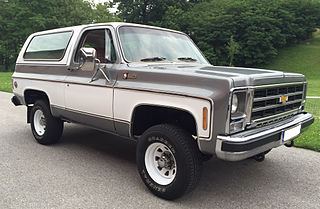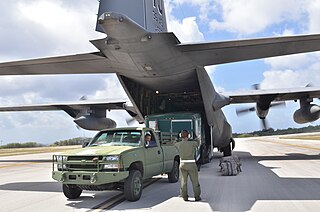
An axle or axletree is a central shaft for a rotating wheel or gear. On wheeled vehicles, the axle may be fixed to the wheels, rotating with them, or fixed to the vehicle, with the wheels rotating around the axle. In the former case, bearings or bushings are provided at the mounting points where the axle is supported. In the latter case, a bearing or bushing sits inside a central hole in the wheel to allow the wheel or gear to rotate around the axle. Sometimes, especially on bicycles, the latter type axle is referred to as a spindle.

The Ram pickup is a full-size pickup truck manufactured by Stellantis North America and marketed from 2010 onwards under the Ram Trucks brand. The current fifth-generation Ram debuted at the 2018 North American International Auto Show in Detroit, Michigan, in January of that year.

The Jeep Comanche is a pickup truck variant of the Cherokee compact SUV (1984–2001) manufactured and marketed by Jeep for model years 1986-1992 in rear wheel (RWD) and four-wheel drive (4WD) models as well as two cargo bed lengths: six-foot and seven-foot.

The Dodge Power Wagon is a four wheel drive medium duty truck that was produced in various model series from 1945 to 1980 by Dodge. The Power Wagon name was revived for the 2005 model year as a four-wheel drive version of the Dodge Ram 2500. As a nameplate, "Power Wagon" continues as a four-wheel drive version of 3/4 ton Ram Trucks 2500 model.

The Dodge B series was a range of full-size vans that were produced by Chrysler Corporation from 1970 to 2003. Through their production, the full-size vans were sold under several different nameplates. Most examples were sold by the Dodge division, although rebadged versions were sold by the now-defunct Fargo and Plymouth divisions. Despite many customer requests, the B-series was not available in the desired 360 V8 model until 1972.

The GMC Motorhome is a recreational vehicle that was manufactured by the GMC Truck & Coach Division of General Motors for model years 1973–1978 in Pontiac, Michigan, USA — as the only complete motorhome built by a major auto/truck manufacturer. Manufactured in 23 and 26 ft lengths, the design was noted for its front-wheel drive and its low profile, fully integrated body.

The Chevrolet K5 Blazer is a full-size sport-utility vehicle that was built by General Motors. GM's smallest full-size SUV, it is part of the Chevrolet C/K truck family. Introduced to the Chevrolet line for the 1969 model year, the K5 Blazer was replaced for 1995 by the Chevrolet Tahoe. The third generation was simply called "Chevrolet Blazer", without the K5 name. In 1970, GMC introduced its own model of the truck, called the Jimmy, which was discontinued in 1991 and replaced by the Yukon. The "Jimmy" name was chosen to reflect how GM may sound in a similar manner to how Jeep was thought to be a pronunciation of GP in the competing market. Both were short-wheelbase trucks and available with either rear- or four-wheel drive.

The General Motors K platform was the automobile platform designation used for the rear wheel drive Cadillac Seville midsize luxury models from 1975 to 1979.

The Dodge Ram SRT-10 is a sport pickup truck that was produced by American automaker Dodge in limited numbers. It was introduced at the January 2002 North American International Auto Show, but was not put into production until 2004.

The Commercial Utility Cargo Vehicle (CUCV) is a vehicle program instituted to provide the United States military with light utility vehicles based on civilian trucks.
The 10.5" Corporate 14 Bolt Differential is a heavy duty differential found on many 1973-2013 Chevrolet and GMC trucks and SUVs, as well as certain versions of the Cadillac Escalade. Additionally, this differential is found on Chevrolet Express and GMC Savanna vans produced from 1973 to current day. Debuting in 1973, this differential is a full floating design with a ring gear diameter of 10.5 inches (270 mm). As the name implies, this differential has 14 bolts holding on the differential cover. The ring gear is not held on with 14 bolts, but rather 12. The 14 bolt differential is a popular axle swap option for Jeep Wrangler owners, and is referred to as the "corporate" 14 bolt because of the odd nature of GM's corporate structure in the 1970s.

The Dana/Spicer Model 60 is an automotive axle manufactured by Dana Holding Corporation and used in OEM pickup and limited passenger car applications by Chevrolet, Dodge, Chrysler, Jeep, Ford and Land Rover. There are front and rear versions of the Dana 60. It can be readily identified by its straight axle tubes, 10 bolt asymmetrical cover, and a "60" cast into the housing. Gross axle weight ratings are often lowered by the vehicle manufacturer for safety and tire reasons. They are also lowered to reduce loads on other powertrain components such as transmissions and transfer cases. Dana 60 Axles are also increasingly swapped into many custom offroad applications to accommodate larger tires and deep compound gearing with locking differentials.
The Dana/Spicer Model 70 is an automotive axle manufactured by Dana Holding Corporation and has been used in OEM heavy duty applications by Chevrolet, Dodge, and Ford. It can be identified by its straight axle tubes, 10 bolt asymmetrical cover, and a "70" cast in to the housing and is visually similar to the Dana 60. The majority of the Dana 70s are rear axles, however Dana 70 front axles do exist. Both front and rear axle variations were first offered in 1957. The Dana 70 is generally regarded to have more strength than a Dana 60 but not as much as a Dana 80. Gross axle weight ratings are often lowered by the vehicle manufacturer for safety and tire reasons.

The Dana/Spicer Model 80 is an automotive axle manufactured by Dana Holding Corporation and has been used in OEM heavy duty applications by Chevrolet, Dodge, and Ford. It can be identified by its straight axle tubes, 10 bolt asymmetrical cover, and a "80" cast into the housing. Dana 80's are made as full floating, rear axles only and are step up in overall strength compared to the Dana 70. 1988 Ford was the first company to use the Dana 80. The Dana 80 has a GAWR up to 11,000 pounds (5,000 kg), however it is common practice among manufacturers to derate Dana 80's. Gross axle weight ratings are lowered by the vehicle manufacturer for safety and tire reasons. The OEM Limited slip differential originally was a "Power Lok" until 1998 when the "Trac Lok" phased it out. Trac Loks were a $350.00 USD option with Ford Super Duty trucks. The Dana 80 Trac Lok is unique being it is a 4 pinion unit, unlike other Dana Trac Lok units with 2 pinions. This was the only rear axle available for the 2nd generation Dodge Ram 3500 trucks.

The Dana/Spicer Model 44 is an automotive axle manufactured by Dana Holding Corporation and is used extensively among automobile manufacturers and in the automotive aftermarket area as well. The Dana 44 was first manufactured in the 1940s and is still being manufactured today, both front and rear axle variants. The Dana 44 has been manufactured as a beam axle and independent suspension for both front and rear axle setups. There are also different variations of the Dana 44. Over a dozen automobile manufacturers have made vehicles that have Dana 44 axles, including Jeep which currently manufactures four-wheel drive vehicles that have both front and rear Dana 44 axles.

The Chevrolet Van or Chevy Van is a range of vans that was manufactured by General Motors from the 1964 to 1996 model years. Introduced as the successor for the rear-engine Corvair Corvan/Greenbrier, the model line also replaced the panel van configuration of the Chevrolet Suburban. The model line was sold in passenger van and cargo van configurations as well as a cutaway van chassis that served as the basis for a variety of custom applications.
The Ford 9-inch is an automobile axle manufactured by Ford Motor Company. It is known as one of the most popular axles in automotive history. It was introduced in 1957 model year cars and ended production in 1986, having been phased out in favor of the Ford 8.8 inch axle. However, aftermarket companies still produce the 9-inch design. It is a semi-floating drop-out axle and had a GAWR up to 3,600 lb (1,630 kg).
The Ford 8.8 is an automotive axle manufactured by Ford Motor Company at the Sterling Axle Plant in Sterling Heights, MI. It was first used in model year 1983 Ford trucks. The axle was developed to replace the Ford 9-inch axle. This axle is still in production today for a variety of Ford vehicles.

In 1939 Dodge presented a completely new designed line of pickups and trucks. Formally the T series for 1939, V series for 1940, and the W series from 1941 through 1947, the trucks became mostly known as the Dodge Job-Rated trucks.

The second generation of the C/K series is a range of trucks that was manufactured by General Motors. Marketed by both the Chevrolet and GMC divisions from the 1967 to 1972 model years, this generation was given the "Action Line" moniker by General Motors. As with its predecessor, the second generation C/K included full-size pickup trucks, chassis cab trucks, and medium-duty commercial trucks.
















